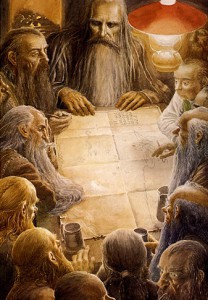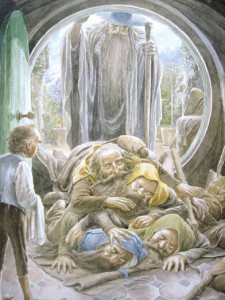 In expanding on Professor Tolkien’s text in his film adaptation, director Peter Jackson allows us to follow Gandalf the Grey into areas that remain secret to us within the text of The Hobbit. As we look forward seeing these events unfold before our eyes next month, this essay by Tedoras examines Gandalf’s journey into the dark fortress of Dol Guldur, what he found there, and the impact that this event had on the fate of Middle-earth.
In expanding on Professor Tolkien’s text in his film adaptation, director Peter Jackson allows us to follow Gandalf the Grey into areas that remain secret to us within the text of The Hobbit. As we look forward seeing these events unfold before our eyes next month, this essay by Tedoras examines Gandalf’s journey into the dark fortress of Dol Guldur, what he found there, and the impact that this event had on the fate of Middle-earth.
On the Finding of Thror’s Map and the Key to the Lonely Mountain
By Tedoras
As most of you already know, one of the most anticipated events in Peter Jackson’s The Desolation of Smaug is Gandalf’s journey into Dol Guldur. In Tolkien’s novel, however, Gandalf’s return to the fortress takes place long before Thorin and Company’s own journey – in the year 2850 of the Third Age. It was on this earlier venture that Gandalf discovered Thrain, father of Thorin, locked in the dungeons. A crazed, tormented Dwarf he had become; and from him, Gandalf received a key and a map. It is easy to consider this event as merely trivial in the grand scheme of things – to brush it off as simply “moving the story along” — but this couldn’t be more wrong.
As it turns out, Gandalf’s finding of the map and key to the Lonely Mountain is one of the most important turns of fate in the entire Third Age. But beyond that, I am willing to argue that this event — small as it may seem — is trumped, in momentousness and primacy, only by very few others: the creation of the Silmarils, the War of Wrath (which can be seen as contingent upon the former), the forging of the One Ring, and maybe a handful of other special incidents in the storied history of Middle-earth. The special importance of Gandalf’s finding the map and key remains, in my mind, the third greatest “triggering”, or “mobilizing”, event after Feanor’s crafting of the Silmarils and Sauron’s forging of the One. Let’s now take a closer look at this incident (and Gandalf himself), and see if it can live up to my aforementioned claims.
We must turn now to “The Quest for Erebor”, from the Unfinished Tales – in which Frodo and others finally have the opportunity to question Gandalf while recovering in Minas Tirith – following the destruction of the Ring. The conversation turns to Bilbo’s quest, and Gandalf’s role in getting that hobbit out the door and onto the road. Gandalf first explains the trouble he had in convincing Thorin that secrecy was the only way back into the Lonely Mountain, and that Bilbo was a necessary part of any secret quest.
 Thorin – perhaps justly – was flummoxed at Gandalf’s suggestion when he met Bilbo at last. Gandalf recalls how Thorin “thought then that [Gandalf] had planned the whole affair simply so as to make a mock of him.” However, just as Thorin was prepared to scorn Gandalf entirely, “it was only the map and key that saved the situation” (338). And Gandalf further recalls “a dangerous journey…ninety-one years before,” when he first held the portentous map and key, and “it began now to look less like chance” to him (338). Certainly, the importance of this discovery cannot be overstated – for “as soon as Thorin saw them, he really made up his mind to follow [Gandalf’s] plan, as far as a secret expedition went at any rate” (338).
Thorin – perhaps justly – was flummoxed at Gandalf’s suggestion when he met Bilbo at last. Gandalf recalls how Thorin “thought then that [Gandalf] had planned the whole affair simply so as to make a mock of him.” However, just as Thorin was prepared to scorn Gandalf entirely, “it was only the map and key that saved the situation” (338). And Gandalf further recalls “a dangerous journey…ninety-one years before,” when he first held the portentous map and key, and “it began now to look less like chance” to him (338). Certainly, the importance of this discovery cannot be overstated – for “as soon as Thorin saw them, he really made up his mind to follow [Gandalf’s] plan, as far as a secret expedition went at any rate” (338).
Thus, we are to understand, from what Gandalf says, that the only reason Thorin pursued the quest secretly was due to the discovery of Thror’s Map and the key to the Mountain. Of course, had Thorin decided not to take Gandalf’s advice (motivated as he was by the return of these heirlooms), and instead risked a more open return to Erebor, the quest would almost surely have failed.
At this point, however, while we can attribute the success of the journey to the finding of the key and map – Bilbo and the Ring had yet to enter the picture. And Gandalf, too, in his abounding wisdom, recognized this dilemma. Gandalf discloses that he just “knew in [his] heart that Bilbo must go with [Thorin], or the whole quest would be a failure — or… the far more important events, by the way, would not come to pass (339, emphasis added). Gandalf argues with Thorin over Bilbo: “a foresight is on me,” Gandalf proclaims, “and I am warning you” (339).
Ultimately, as we know (and are thankful for), Thorin agrees to take Bilbo – permitting that Gandalf comes too. Thus, the second piece of our puzzle fits. Thorin first agrees to pursue the quest secretly, due to the discovery of the map and key. Second, he agrees to take Bilbo with him – 1) because Gandalf returned to speak with him (and convinced him of Bilbo’s worth), when finally he decided to reveal the map and key; and 2) because of the stealthy nature of the quest. It is from Gandalf’s hinting at the Dwarves’ need of secrecy, and his simultaneous push to get them to take the hobbit, that the notion of Bilbo being a thief, burglar, or “professional stealth” (according to Balin) arises.


